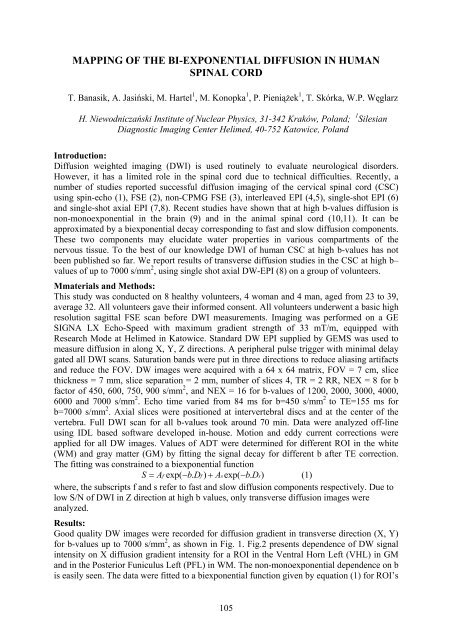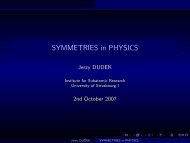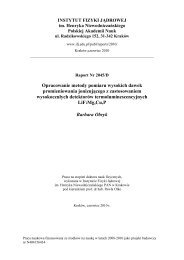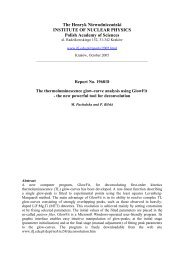Report No xxxx - Instytut Fizyki JÄ drowej PAN
Report No xxxx - Instytut Fizyki JÄ drowej PAN
Report No xxxx - Instytut Fizyki JÄ drowej PAN
You also want an ePaper? Increase the reach of your titles
YUMPU automatically turns print PDFs into web optimized ePapers that Google loves.
MAPPING OF THE BI-EXPONENTIAL DIFFUSION IN HUMAN<br />
SPINAL CORD<br />
T. Banasik, A. Jasiński, M. Hartel 1 , M. Konopka 1 , P. Pieniążek 1 , T. Skórka, W.P. Węglarz<br />
H. Niewodniczański Institute of Nuclear Physics, 31-342 Kraków, Poland; 1 Silesian<br />
Diagnostic Imaging Center Helimed, 40-752 Katowice, Poland<br />
Introduction:<br />
Diffusion weighted imag ing (DWI) is used routinely to evaluate neurological disorders.<br />
However, it has a limited role in the spinal cord due to technical difficulties. Recently, a<br />
number of studies reported successful diffusion imaging of the cervical spinal cord (CSC)<br />
using spin-echo (1), FSE (2), non-CPMG FSE (3), interleaved EPI (4,5), single-shot EPI (6)<br />
and single-shot axial EPI (7,8). Recent studies have shown that at high b-values diffusion is<br />
non-monoexponential in the brain (9) and in the animal spinal cord (10,11). It can be<br />
approximated by a biexponential decay corresponding to fast and slow diffusion components.<br />
These two components may elucidate water properties in various compartments of the<br />
nervous tissue. To the best of our knowledge DWI of human CSC at high b-values has not<br />
been published so far. We report results of transverse diffusion studies in the CSC at high b–<br />
values of up to 7000 s/mm 2 , using single shot axial DW-EPI (8) on a group of volunteers.<br />
Mmaterials and Methods:<br />
This study was conducted on 8 healthy volunteers, 4 woman and 4 man, aged from 23 to 39,<br />
average 32. All volunteers gave their informed consent. All volunteers underwent a basic high<br />
resolution sagittal FSE scan before DWI measurements. Imaging was performed on a GE<br />
SIGNA LX Echo-Speed with maximum gradient strength of 33 mT/m, equipped with<br />
Research Mode at Helimed in Katowice. Standard DW EPI supplied by GEMS was used to<br />
measure diffusion in along X, Y, Z directions. A peripheral pulse trigger with minimal delay<br />
gated all DWI scans. Saturation bands were put in three directions to reduce aliasing artifacts<br />
and reduce the FOV. DW images were acquired with a 64 x 64 matrix, FOV = 7 cm, slice<br />
thickness = 7 mm, slice separation = 2 mm, number of slices 4, TR = 2 RR, NEX = 8 for b<br />
factor of 450, 600, 750, 900 s/mm 2 , and NEX = 16 for b-values of 1200, 2000, 3000, 4000,<br />
6000 and 7000 s/mm 2 . Echo time varied from 84 ms for b=450 s/mm 2 to TE=155 ms for<br />
b=7000 s/mm 2 . Axial slices were positioned at intervertebral discs and at the center of the<br />
vertebra. Full DWI scan for all b-values took around 70 min. Data were analyzed off-line<br />
using IDL based software developed in-house. Motion and eddy current corrections were<br />
applied for all DW images. Values of ADT were determined for different ROI in the white<br />
(WM) and gray matter (GM) by fitting the signal decay for different b after TE correction.<br />
The fitting was constrained to a biexponential function<br />
S = Af<br />
exp( −b.<br />
Df<br />
) + Asexp(<br />
−b.<br />
Ds)<br />
(1)<br />
where, the subscripts f and s refer to fast and slow diffusion components respectively. Due to<br />
low S/N of DWI in Z direction at high b values, only transverse diffusion images were<br />
analyzed.<br />
Results:<br />
Good quality DW images were recorded for diffusion gradient in transverse direction (X, Y)<br />
for b-values up to 7000 s/mm 2 , as shown in Fig. 1. Fig.2 presents dependence of DW signal<br />
intensity on X diffusion gradient intensity for a ROI in the Ventral Horn Left (VHL) in GM<br />
and in the Posterior Funiculus Left (PFL) in WM. The non-monoexponential dependence on b<br />
is easily seen. The data were fitted to a biexponential function given by equation (1) for ROI’s<br />
105

















